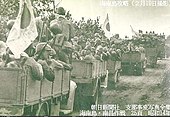Hainan Island Operation
| Hainan Island Operation | |||||||||
|---|---|---|---|---|---|---|---|---|---|
| Part of theSecond World War | |||||||||
 Imperial Japanese Army soldiers in trucks during the invasion of Hainan (Asahi Shinbunnews photo) | |||||||||
| |||||||||
| Belligerents | |||||||||
|
|
| ||||||||
| Commanders and leaders | |||||||||
|
|
| ||||||||
| Units involved | |||||||||
|
|
| ||||||||
| Strength | |||||||||
| Elements ofIJN 5th Fleet | 25,000 | ||||||||
| Casualties and losses | |||||||||
| Unknown | 3,000 killed | ||||||||
This article includes alist of references,related reading,orexternal links,but its sources remain unclear because it lacksinline citations.(June 2023) |
TheHainan Island Operation(Chinese:Quỳnh nhai chiến dịch), orKainan-tō sakusen(Hải nam đảo tác chiến)inJapanese,was part of a campaign by theEmpire of Japanduring theSecond World Wartoblockadethe Guangdong mainland and prevent it from communicating with the outside world and from receiving imports of much-needed arms and materials.
Background
[edit]HainanIsland lies midway betweenFrench IndochinaandBritish Hong Kong,occupying a position south of theLeizhou Peninsulaacross the Strait of Hainan. It is also nearKwangchowan,a French-leased territory on the southern coast of China. The Hainan Island has an area of 33,920 square kilometres (13,100 sq mi), and had a population of 2,200,000 at the time. The island was guarded by the 152nd Division, approximately 25,000 strong, under the command ofYu Hanmou,who was in charge of peace preservation in Guangdong Province.
The Japanese Navy, after the capture of Canton (Guangzhou) the previous year, had maintained a formidable blockade all along the coast of south, central and north China. However, loopholes were found in the southern end of the blockade line. These included the supply route toChiang Kai-shekwith Hong Kong and Northern French Indochina as relay points and direct routes through Hainan Island andKwangchowan.Because of these loopholes, as well as the necessity to conduct air operations deep into the interior of China, as far as theKunmingarea, the Japanese Navy came to feel the necessity of establishing air bases on Hainan Island. The Central Authorities of the Navy advocated for this move. Operations were carried out by theSpecial Naval Landing ForceswithArmyelements supporting them.
Operation
[edit]Escorting a convoy, theSouth China Naval Force (Fifth Fleet)commanded by Vice AdmiralKondo Nobutakeentered and anchored in Tsinghai Bay on the northern shore of Hainan Island at midnight on 9 February 1939 and carried out a successful landing. In addition, Navy land combat units effected a landing atHaikouat 12:00 on 10 February. Thereafter, the Army and Navy forces acted in concert to mop up the northern zone. On 11 February, land combat units landed atSamah(Sanya) at the southern extremity of Hainan Island and occupied the key positions of Yulin and Yai-Hsien. Thereafter, the units engaged in the occupation and subjugation of the entire island.
Retreat to Wuzhi mountain range
[edit]Facing crisis, Nationalist forces evacuated all remaining civilians from Haikou to Qionghai to the safeWuzhimountain range in central Hainan. However, they faced fierce opposition by theethnic Li highlandersthere. An ethnic Li called Wang Guoxing started an uprising but was brutally crushed, and, in revenge, the Nationalists killed 7,000 of Wang Guoxing's family members in his village.[1]
The Communists underFeng Baijuand the nativeLi peopleof Hainan fought a vigorousguerrillacampaign against the Japanese occupation, the Japanese killed large numbers of Li in western Hainan (e.g.Sanya,Danzhou). Furthermore, numerous foreign slave labourers were also killed. There are mass graves of tens of thousands ofKoreanslave labourers in Sanya and throughout the island. Of the 100,000 slave labourers fromHong Kong,only 20,000 survived the war.[citation needed]
Partial occupation of Hainan
[edit]Later, Japanese-occupied parts of Hainan Island became a naval administrative district with Hainan Guard District Headquarters established at Samah. Strategically, the island was built as a forward air base as well as an advance base for blockading Chiang. At the same time, the iron and copper resources of the island were exploited. Partial control of certain areas of Hainan Island provided a base of operations for the invasion ofGuangdongprovince andFrench Indochina,as well as providing airbases that permitted long-distanceair raidsof routes into China from French Indochina andBurma.
The occupation of some parts of Hainan lasted until thesurrender of Japanin September 1945.
See also
[edit]References
[edit]- Japanese Monograph No. 144: POLITICAL STRATEGY PRIOR TO OUTBREAK OF WAR PART I, Prepared by MILITARY HISTORY SECTION HEADQUARTERS, ARMY FORCES FAR EAST, DISTRIBUTED BY OFFICE OF THE CHIEF OF MILITARY HISTORY DEPARTMENT OF THE ARMY, Chapter 4, Operations against China during 1939Pg 46-47.
- Trung quốc kháng nhật chiến tranh chính diện chiến tràng tác chiến ký China's Anti-Japanese War Combat Operations
- Author: Guo Rugui, editor-in-chief Huang Yuzhang
- Press: Jiangsu People's Publishing House
- Date published: 2005-7-1
- ISBN7-214-03034-9
- Online in Chinese[1]
- Đệ thất bộ phân: Tương trì giai đoạn tiền kỳ đích tác chiến hải nam đảo tác chiến 1Hainan Island battles
- Phillips, R. T. "The Japanese Occupation of Hainan,"Modern Asian Studies,Vol. 14, No. 1 (1980), pp. 93–109,[2]
- Hainan Lawyers' group to help ex-'comfort women,'China Daily,2006-03-23,[3]
